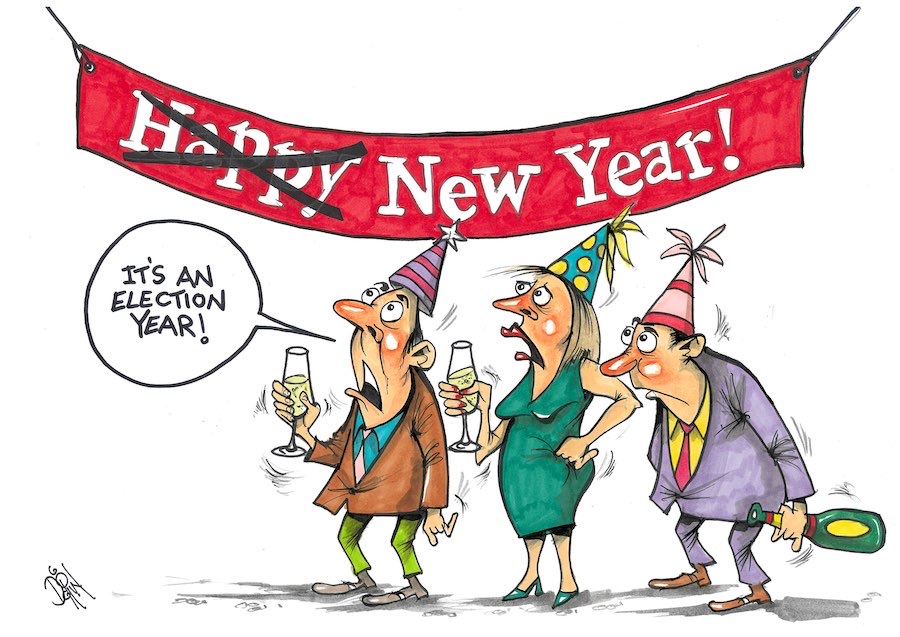
“In this case there is the prospect that Martin Bennett will slowly bury Ms Higgins in a pyramid constructed of inconsistencies. It will be slow, it will be excruciating for everyone, but it will be done with the precision and thoroughness of the ancient Pharaoh’s builders.” HUGH SELBLY looks west to the latest instalment of that ‘saga that will not die’.
Remember the Sofronoff Inquiry (the one that ended badly for our former director of prosecutions and infuriated fearless leader Andrew Barr in 2023)? We could watch it in real time.
What’s more the transcript of everything said each day was usually available by around 6pm. And that’s not all: there were many documents that could be accessed by the public.
Walter Sofronoff KC set the gold standard for “public access to justice”. True he was a tad too accessible to one journalist but we, the interested public, were never shut out.
Remember, still in 2023, we then had the public viewing days in our Integrity Commission’s inquiry into how a local construction company, Manteena, with the best bid, was dealt out of being awarded the contract for the multi-million works at Campbell Primary School. My goodness, that was so many months ago and still no report.
Big tick for the Commission’s efforts, but the value was much less than for Sofronoff’s Inquiry because much of the questioning had no labelling as to what was coming (making it both hard work to follow and boring) and there was no transcript at the end of the day.
Responding to public interest then took a welcome leap upwards with the easy, daily access to that defamation hearing: “He who would go back for his hat” versus “certain media interests”. Justice Michael Lee, of the Federal Court of Australia, repeatedly stated, and implemented, a determination to let us – the interested public – into his courtroom. For completeness, I should also be thankful to his colleague who had allowed similar YouTube access to the earlier Ben Roberts-Smith defamation case.
Justice Lee delivered the key parts of his decision “live”. In so doing he proved that for those of the judiciary who are minded to use today’s technology to enhance open justice it is possible to do so with flying colours.
Fast forward to last Friday when the next instalment of that “saga that will not die” started in the WA Supreme Court. Senator Linda Reynolds is seeking judicial confirmation that she was defamed by Brittany Higgins and consequent monetary compensation.
Rightly or wrongly the common understanding is that any such damages will come from the two million plus nest egg that we taxpayers generously gave to fair Brittany a couple of Christmases ago.
During the awful covid years the WA Supreme Court, like many courts, was adept at using technology to run hearings with the witnesses and lawyers in different locations.
Will the now pregnant defendant, Ms Higgins, be able to give her evidence in the Reynolds case from her home in France, or will she have to travel to Perth?
Given the public interest in this latest defamation hearing it seems obvious that the court should and could have arranged for live streaming – as happened in all the instances discussed above.
But there’s nothing. The imposing façade of the Court building in Perth dates from 1903. Expansion and updating occurred twice in the latter half of the 20th century. In 2024 the court had an unprecedented opportunity to share its stature and talent with the rest of the country. Squibbed.
Instead, we are limited to the well-intentioned but inadequate reporting of mainstream media who seem to have neither knowledge nor experience of litigation or advocacy. Why is this so?
Every week we can follow so many well-known sports with the help of well-informed commentators who can share with us the “what” and the “why” of the good, the bad and the ugly. Roy and HG can even make it hilarious.
Political and financial commentators, too, bring years of experience to what they tell us.
Once upon a time there were some court reporters of the same ilk. Not now. The blind keep us blind. They don’t know what they are missing and so neither do we.
Put on a show, never mind that it’s a judge alone trial
Last Friday the ABC online had up to four reporters sharing excerpts from the senator’s lawyer’s exceedingly long opening address to the trial judge. There was no analysis.
On Monday, the ABC online again had a four-person team and again there was no analysis.
Reporting on the opening address for the defendant we learned that they accuse the senator of: “trying to trivialise Ms Higgins’ alleged rape…”, “laying the blame for her loss of reputation at the feet of a former junior staffer…”, “[by her lawyer’s reference on Friday to a fairytale] harassing and re-traumatising [the defendant]” and, “trivialising the reasons why Ms Higgins spoke out in 2021”.
ABC online also reports that the defence opening included: “We say any reasonable person [ie, the Senator] can and ought to have put two and two together and be concerned, be very concerned that something untoward, something criminal and sexual had occurred.”
That’s an interesting proposition – that a third party should intuit that which was not said, and be open to public criticism from the person who didn’t say it if they fail to do so.
Last Friday the reporting of the Senator’s opening referred to, “photos and texts of Ms Higgins’ time campaigning in Perth show she was happy and liked Senator Reynolds”.
Monday’s rejoinder included this reported claim: “Images or texts of Ms Higgins smiling reflect the fact she was a dedicated Liberal staffer who wanted her party to win the election”.
Please note, given all the reported interaction with Labor politicians, that’s an assertion that opens a wide, wide door to any cross-examiner.
This is a defamation trial before a Supreme Court judge. The preparation by both parties will have required the filing of witness statements and summaries of argument.
The extent to which the trial judge has examined those documents will reflect his approach to the task of judging. Some judges never look at the documents before trial, others always do. Some filed materials have probably been used in those pretrial court appearances seeking to trace what happened to our payout to Ms Higgins, and for those reported attempts to reach a mediated settlement.
Fact laden, emotively charged opening statements can be very important in introducing a case to a jury of laypeople. They have not read any documents before the start of the trial. They do not know the law. Winning their hearts and minds is important.
But, and it’s an important “but”, opening statements should not contain the argument. They are an outline or explanation intended to provide a roadmap to the decision maker as to how the case will be run.
Any opening must not only be tailored to the audience, it must also reflect a risk assessment of what the fact finder and an opponent might do with any “promises” made in the opening.
To open to a judge sitting alone in the same way as to a jury is folly, likely to lead a judge to interrupt the advocate with the message, “there is no jury here”.
However, if the opening is not for the judge but the media sitting in the courtroom, and thereafter through the media filter to us, then the point of the emotion and the implied argument becomes clear. The opening or openings are to us.
That said, a skilled advocate always asks: “What are the risks of making an opening statement? Will I give my opponent valuable ammunition to use when cross-examining my client and any other witness? If so, is it best to decline the invitation to make an opening statement? When acting for a defendant should I make an opening immediately after the plaintiff (as happened in Perth) or should I make it much later? If I make an opening, should it be detailed (as happened on Friday and Monday) or should my opening be clear, short, and rather plain?”
The risks get further attention below.
Defences of truth and qualified privilege
The media interests in Sydney must be ever so thankful that their “truth” defence for the “Project” program succeeded. The plaintiff left without his hat. They owe much to Justice Michael Lee’s exhaustive study of the alcohol consumed on that fateful night, culminating in the “balance of probability” finding of unwanted sex in Senator Reynold’s office space.
That media defence raised another argument of qualified privilege around what was claimed in that now infamous program. That did not succeed.
The same two legal defences are being used in Perth, albeit on different factual bases.
According to Monday’s ABC online: “[The defence] is attempting to demonstrate the truth of Ms Higgins’ claim there was a campaign of harassment by Senator Reynolds against her client.
There are three main points to her argument:
- Senator Reynolds calling Ms Higgins a “lying cow” when she watched Ms Higgins interview on Channel 10’s The Project. “We say that’s not just name calling, that’s harassment,” adding it came at a time when the rape allegation was the subject of fierce public debate and the allegation had not yet been tested in a criminal trial. [The defence] said it was a “disgraceful slur”, which Senator Reynolds later apologised for and paid out a defamation settlement. (I predict that approach will be well answered during the senator’s examination-in-chief this week.)
- Senator Reynolds’ conduct at the criminal trial of Mr Lehrmann. Ms Higgins claims that during that trial, Senator Reynolds, who was a witness, tried to help the defence and acted in a manner that was not impartial.
- The senator backgrounding journalists with documents about Ms Higgins that [the defence ] said she “should not have provided”.
The defence is also asserting that Ms Higgins’ conduct is protected by the defence of qualified privilege as follows. They say: “Ms Higgins was talking about matters of public interest in the social media posts, such as workplace safety in parliament and the performance of a Commonwealth minister, and she was making “fair comment” and giving her ‘honest opinion’.”
They say: “Ms Higgins’ social media posts were immediate responses to comments and media reports in which Senator Reynolds was explicitly attacking her position and account of events”.
They say: “It was in that context Ms Higgins was responding, and the comments did not come ‘out of the blue to besmirch the senator’.”
Buried alive
The assumption is that what a lawyer says in an opening has been approved by their client. An opening is, therefore, a series of promises as to how a party will run their case, what is their storyline.
Bennett Law, the senator’s legal team, are known for their team approach to running litigation. It’s mind-blowingly expensive but thorough. The assertions made in last week’s opening are likely to have been repeatedly checked.
Readers will recall that Bennett Law were relentless these past months in seeking to unravel the details of how Ms Higgins had dealt with the large taxpayer payout to her.
The results have not been made public but must have been good enough for the senator to go on with a five-week trial. By “good enough” I mean that the accessible money pot was seen to have enough to recover both compensation for the senator and what Bennett Law will bill her. Defamation is unusual in that the successful party can recover much more of their legal costs from the loser than in other civil litigation.
The senator is now giving evidence. Her account should bear out what was said in her lawyer Bennett’s opening. It should also anticipate the lines of attack upon both her message and her believability that will come when she is cross-examined.
Such anticipation has been made rather easier by the content of Monday’s opening by the defence. Martin Bennett can introduce topics by way of: “Senator, I am now going to take you to your evidence about such and such that featured in the defence opening”. An example is why she chose to pay Ms Higgins in an earlier court case – referred to above. This approach blunts and deflects any later cross-examination.
Ms Higgins is rather more vulnerable than the senator to a successful cross-examination. Here’s why. Ms Higgins has created a treasure trove of materials by way of media comment, book draft, emails and sworn evidence at both a criminal and civil trial.
In this digital age all of it will have been stored. All of it can be searched in an instant by any number of key terms and the results laid out to be picked up and deployed when she is cross-examined.
When Ms Higgins gives her evidence in some weeks, whether that is from the witness box or via audio visual link from France, the Bennett team will be waiting for any departure from a past claim. Each variation will then become another bit of potential ammunition.
Justice Michael Lee concluded his lengthy evaluation of Ms Higgins and her evidence before him as follows:
“In summary, and after having had the opportunity of observing Ms Higgins’ demeanour closely over approximately four and a half days and comparing her testimony to other documentary and oral evidence I accept as being cogent, it would be fair to describe her as a complex and, in several respects, unsatisfactory witness. Nuance is required in evaluating her evidence and any contentious or uncorroborated aspect needs to be scrutinised warily.”
That evaluation will not influence the Perth judge; however, it is a guiding light for those at Bennett Law preparing to cross-examine her.
Drawing attention to earlier statements, both written and spoken, that are different to what that witness has said during their evidence-in-chief is a well-known cross-examination technique. It is called impeachment by prior inconsistent statement.
The technique is often overused, especially to highlight minor inconsistencies. However, in this case there is the prospect that Mr Bennett will slowly bury Ms Higgins in a pyramid constructed of inconsistencies.
It will be slow, it will be excruciating for everyone, but it will be done with the precision and thoroughness of the ancient Pharaoh’s builders. We can expect it to be enduring.
Monday’s opening may prove to provide the nails for the entombed casket in which the senator intends to bury her detractor.
In a nutshell, any exaggeration, any misstatement in an opening can be a double boon to a confident opponent, for use both when they rebut the claims in their witness evidence, and when they cross examine the “owner” of that opening.
It would be wonderful if we, the paying public, could see this play out in real time on a YouTube channel, rather than rely on non-player accounts. It is, after all, 2024 not 1984.
Who can be trusted?
In a world of spin and confusion, there’s never been a more important time to support independent journalism in Canberra.
If you trust our work online and want to enforce the power of independent voices, I invite you to make a small contribution.
Every dollar of support is invested back into our journalism to help keep citynews.com.au strong and free.
Thank you,
Ian Meikle, editor





Leave a Reply